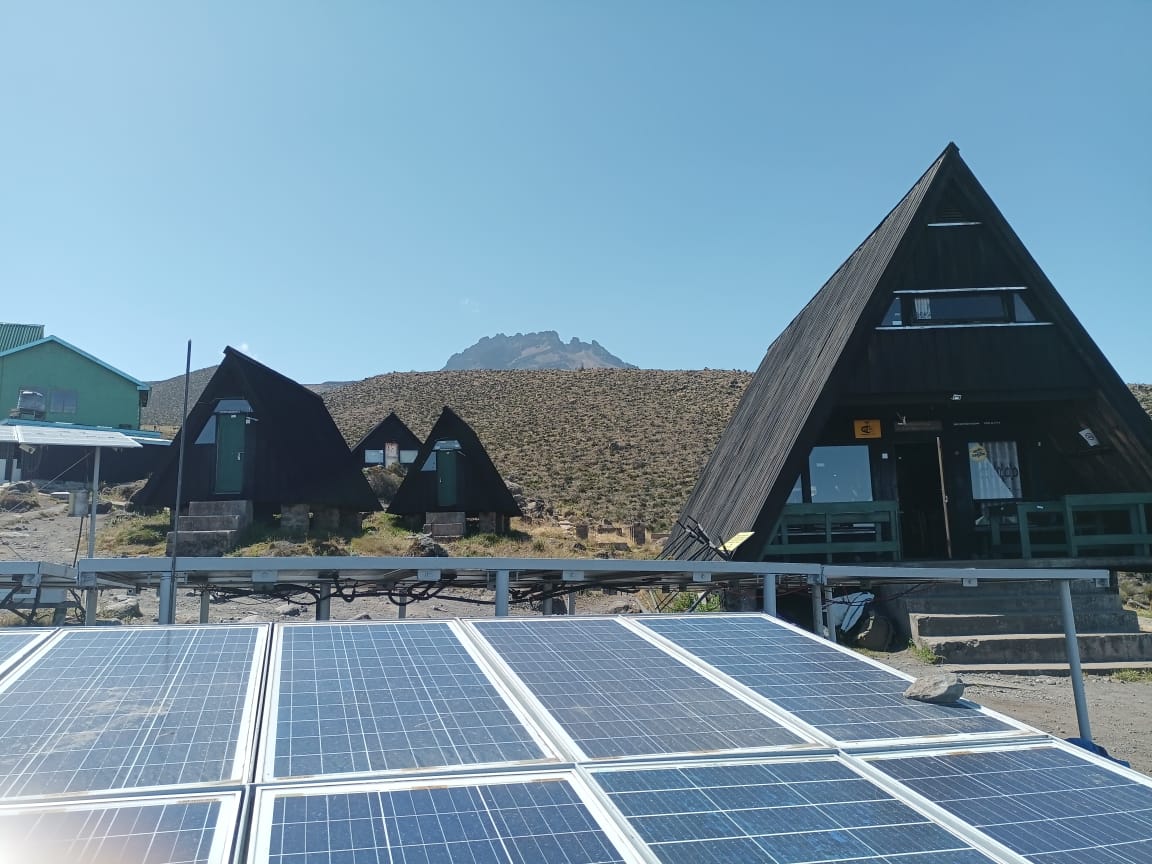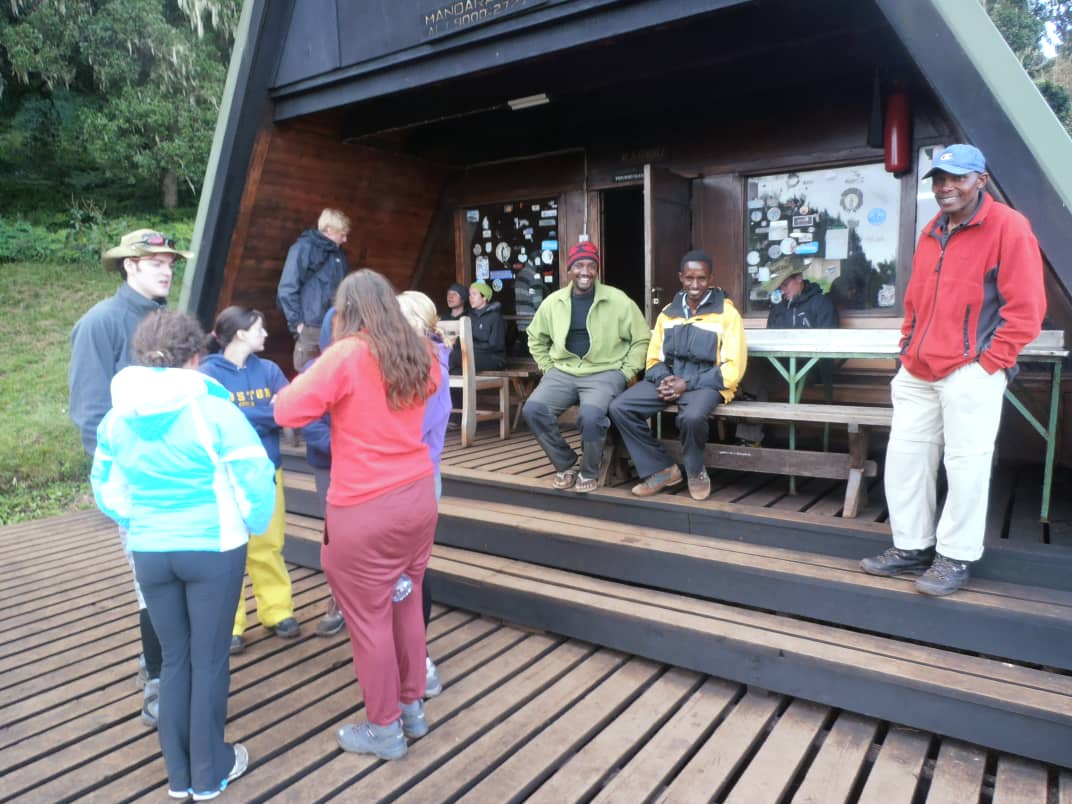
MT.Kilimanjaro Marangu Routs
MARANGU ROUTE 5 DAYS
5 Days/4 Nights - Itinerary for the Marangu route
Marangu route offers one of the best opportunities to climb a peak at high altitude without technical climbing ability. It is considered to be the easiest trekking trail (known as Coca Cola route) and unlike the other routes Marangu route has mountain huts so we don’t require tents or camping. The trail start from Marangu gate where Kilimanjaro National Park’s head quarters are situated and this is the first route to be established and used by the first German’s mountain conqueror. The typical duration on this route is 5 days on the mountain but you can add an extra day for acclimatization at Horombo hut where you will spend this day by hiking up to Zebra rocks or Mawenzi ridge.
The drive from Arusha to the Kilimanjaro National Park gate, takes about 2hrs. In Moshi the journey passes through the village of Marangu, which is located on the lower slopes of the mountain. Once you reach the park gate, all hikers are requested to sign in at the Park's office and make their final preparations for the climb. You now leave the Park gate and ascend on a cleared ridge trail through the rain forest. The forest, suffused with mist and dripping with beards of moss, is also where most of Kilimanjaro's animals are found. Diner and overnight at Mandara hut.
Day 2: Mandara hut (2700m) - Horombo hut (3720m). 6 hours
From Mandara hut the trail passes through a short stretch of forest, then skirts the base of the Maundi Crater and then emerges into the transition from rain forest to moorland. It is well worth a short detour to scramble up the rim of the Maundi Crater for your first really impressive view of the Kibo Crater. On a clear day, Kibo will glimmer in the distance, showing off her majestic glaciers in the morning sun. Once you are in the open moorland you will get the chance to see some of Kilimanjaro's most spectacular plants - the endemic giant lobelia which grows up to 3 m in height and the giant groundsel (Senecia kilimanjari), which can reach heights of 5m! Diner and overnight at Horombo hut.
Day 3: Horombo hut (3720m) - Kibo hut (4700m) 6 hours
After breakfast you now continue your ascent into the Alpine desert habitat. The summit is now a further 1195m up and you will make your final ascent the same night. Prepare your summit equipment and go to bed at round about 19h00 and try to get as much rest and sleep as possible.
Day 4: SUMMIT ATTEMPT, Kibo hut (4700m) - Uhuru Peak (5895m) 6 to 7 hours - Horombo hut (3720m). 6 hours
You will rise around 23h30, and after some tea and biscuits you shuffle off into the night, and this is where it gets really tough and changes. The first section of the trail consists of a rocky path to the Hans Meyer Cave (5150m), also a good resting spot. The path then zigzags up to Gillman's point (5 681m), which is located on the crater rim then continue for about 1 hours to get to the highest poing (Uhuru Peak 5895m). Total exhilaration and satisfaction - you made it. Weather conditions on the summit will determine how long you will be able to spend, taking photographs, before the 3 hour descent back to Kibo hut. After a short rest you gather all your gear you left behind for the ascent and head down to Horombo hut (3 hours) for your overnight.
Day 5: Horombo hut (3720m) - Marangu Gate (1980m). 6 hours
After breakfast you continue your descent (6 hours), passing the Mandara hut, down to the Marangu gate. At Marangu gate you sign your name and details in a register. This is also where successful climbers receive their summit certificates. Those climbers who reached Gillman's Point (5685m) are issued with green certificates and those who reached Uhuru Peak (5895m), receive gold certificates. You now drive back to Arusha for a long overdue hot shower, dinner and celebrations!!
End of the climb
MARANGU ROUTE 6 DAYS.
6 Days/5 Nights on the mountain – recommended
Marangu route offers one of the best opportunities to climb a peak at high altitude without technical climbing ability. It is considered to be the easiest trekking trail (known as Coca Cola route) and unlike the other routes Marangu route has mountain huts so we don’t require tents or camping. The trail start from Marangu gate where Kilimanjaro National Park’s head quarters are situated and this is the first route to be established and used by the first German’s mountain conqueror. The typical duration on this route is 5 days on the mountain but you can add an extra day for acclimatization at Horombo hut where you will spend this day by hiking up to Zebra rocks or Mawenzi ridge.
Day 1: Marangu Gate (1980m) - Mandara hut (2700m). 3-4 hours
The drive from Arusha to the Kilimanjaro National Park gate, takes about 2hrs. The journey passes Moshi town and through the village of Marangu, which is located on the lower slopes of the mountain. Once you reach the park gate, all hikers are requested to sign in at the Park's office and make their final preparations for the climb. You now leave the Park gate and ascend on a cleared ridge trail through the rain forest. The forest, suffused with mist and dripping with beards of moss, is also where most of Kilimanjaro's animals are found. Diner and overnight at Mandara hut.
Day 2: Mandara hut (2700m) - Horombo hut (3720m). 6 hours
From Mandara hut the trail passes through a short stretch of forest, then skirts the base of the Maundi Crater and then emerges into the transition from rain forest to moorland. It is well worth a short detour to scramble up the rim of the Maundi Crater for your first really impressive view of the Kibo Crater. On a clear day, Kibo will glimmer in the distance, showing off her majestic glaciers in the morning sun. Once you are in the open moorland you will get the chance to see some of Kilimanjaro's most spectacular plants - the endemic giant lobelia which grows up to 3 m in height and the giant groundsel (Senecia kilimanjari), which can reach heights of 5m! Diner and overnight at Horombo hut.
Day 3: Horombo hut (3720m) –Acclimatization day
Horombo hut is a village of huts perched on a small plateau, with buildings similar to Mandara, but with a total capacity of 120 climbers! Horombo is normally bustling with hikers, guides and porters, with an atmosphere of adventure and excitement. You will meet both ascending and descending hikers here. This extra day and night at Horombo is for additional acclimatization. A hike towards the Mawenzi hut, passing the Zebra Rocks on the way (about 3 hours up and 1,5 hours down), is strongly recommended. This hike will further assist with the process of acclimatization. Remember to drink enough water and move slowly! All meals for the day are provided at the hut. Retire to bed early and get a last good night's rest.
Day 4: Horombo hut (3720m) - Kibo hut (4700m) 6 hours
After breakfast you now continue your ascent into the Alpine desert habitat. The summit is now a further 1195m up and you will make your final ascent the same night. Prepare your summit equipment and go to bed at round about 19h00 and try to get as much rest and sleep as possible.
Day 5: Summit - Kibo hut (4700m) - Uhuru Peak (5895m) 6 to 7 hours - Horombo hut (3720m). 6 hours
You will rise around 23h30, and after some tea and biscuits you shuffle off into the night, and this is where it gets touch and challenges. The first section of the trail consists of a rocky path to the Hans Meyer Cave (5150m), also a good resting spot. The path then zigzags up to Gillman's point (5 681m), which is located on the crater rim then continue for about 1 hours to get to the highest point (Uhuru Peak 5895m). Total exhilaration and satisfaction - you made it. Weather conditions on the summit will determine how long you will be able to spend, taking photographs, before the 3 hour descent back to Kibo hut. After a short rest you gather all your gear you left behind for the ascent and head down to Horombo hut (3 hours) for your overnight.
Day 6: Horombo hut (3720m) - Marangu Gate (1980m). 6 hours
After breakfast you continue your descent (6 hours), passing the Mandara hut, down to the Marangu gate. At Marangu gate you sign your name and details in a register. This is also where successful climbers receive their summit certificates. Those climbers who reached Gillman's Point (5685m) are issued with green certificates and those who reached Uhuru Peak (5895m), receive gold certificates. You now drive back to Arusha for a long overdue hot shower, dinner and celebrations!!
End of the climb
The following is on offer:
Mto wa Mbu is situated on the way from Arusha to the national parks in northern Tanzania, just at the foot of the Rift Valley. Located on the way to Ngorongoro and Serengeti, it is an ideal resting place for most safari travellers. A visit to Mto Wa Mbu includes: A walk thought the farms in the green oasis at the foot of the Rift Valley - A climb to Balaa Hill from where you can see the whole town - A view into the culture of the many different tribes living in the area - A trip to the Miwaleni Lake and waterfall - Visit to development projects that aim at improving agriculture and start income generating activities for the farmers - Explanation about the irrigation system







